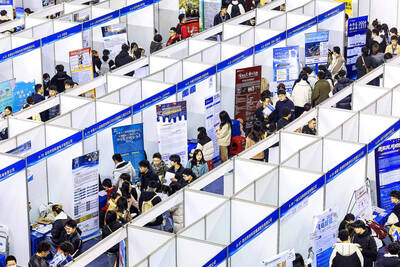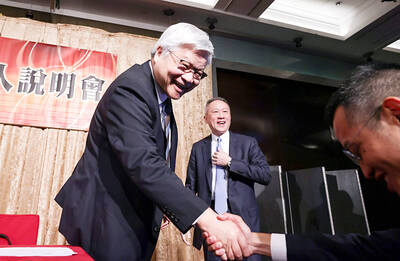Chinese manufacturers that dominate nearly every step in the global solar power supply chain are being forced to slash prices as the COVID-19 pandemic disrupts projects around the world.
Costs for components, such as wafers and cells, have fallen by as much as 20 percent since the start of the year.
They likely have not bottomed out yet, either, as the outlook for demand remains uncertain and new mega-factories threaten to add supply.
It is bad news for the companies that make solar components and could lead to consolidation among some of the smaller players in the industry.
The bargain-basement prices, though, could also spur demand for a solar boom when the global economy recovers.
“The coronavirus added uncertainties to demand, especially overseas. Prices are still under certain pressure,” CMB International Securities Ltd (招銀國際證券) analyst Robin Xiao said. “But if the world is gradually recovering from the epidemic from the fourth quarter, cheaper prices may significantly raise competitiveness of photovoltaics.”
The virus has disrupted new solar projects around the world as government efforts to slow the spread of the disease have kept workers away from installation sites, while the economic collapse has threatened funding for new projects.
New global capacity added this year is now forecast to be 19 percent less than before the epidemic broke out, according to BloombergNEF (BNEF).
The supply chain that creates those solar power plants is almost entirely housed within China. From producing polysilicon ingots, cutting them into wafers, forming those into cells to combine into panels, Chinese factories comprise at least 73 percent of global capacity in every step, BNEF data showed.
With installations slowing, solar giants LONGi Green Energy Technology Co (隆基綠能科技) and Tongwei Co (通威太陽能) have had to cut product prices several times in the past two months to maintain market share.
Wafers and cells have become at least 20 percent cheaper this year, while panel prices eased 10 percent, BNEF data showed.
Chinese manufacturing might have been one of the reasons solar costs have fallen so much over the past decade that they are now a cheaper source of new, albeit intermittent, power than coal in many parts of the world.
To be sure, some of this year’s cost cuts have been due to technological advances, such as LONGi being able to reduce the thickness of its wafers.
BNEF expects wafer prices to continue to drop in the second half as more production is released. Prices could fall another 15 percent to about US$0.28 per standard piece.
That could spell consolidation for smaller players in the field. Even after dropping wafer prices by 20 percent, LONGi still has at least a 15 percent profit margin, Daiwa Capital Markets Hong Kong Ltd analyst Dennis Ip (葉捷賢) said.
A further 5 to 10 percent cut in prices could effectively wipe out most small manufacturers, he said.
“It’s a great window for tier-one producers to collect market share,” he said. “The oligarch structure would get further strength.”
Several top manufacturers announced aggressive expansion plans earlier this year even as the industry grappled with lower prices.
Tongwei is planning to double its cell production capacity, already the world’s largest, while GCL System Integration Technology Co (協鑫集成科技) is considering building the world’s largest panel plant that by itself would be able to meet half of global demand.

Stephen Garrett, a 27-year-old graduate student, always thought he would study in China, but first the country’s restrictive COVID-19 policies made it nearly impossible and now he has other concerns. The cost is one deterrent, but Garrett is more worried about restrictions on academic freedom and the personal risk of being stranded in China. He is not alone. Only about 700 American students are studying at Chinese universities, down from a peak of nearly 25,000 a decade ago, while there are nearly 300,000 Chinese students at US schools. Some young Americans are discouraged from investing their time in China by what they see

MAJOR DROP: CEO Tim Cook, who is visiting Hanoi, pledged the firm was committed to Vietnam after its smartphone shipments declined 9.6% annually in the first quarter Apple Inc yesterday said it would increase spending on suppliers in Vietnam, a key production hub, as CEO Tim Cook arrived in the country for a two-day visit. The iPhone maker announced the news in a statement on its Web site, but gave no details of how much it would spend or where the money would go. Cook is expected to meet programmers, content creators and students during his visit, online newspaper VnExpress reported. The visit comes as US President Joe Biden’s administration seeks to ramp up Vietnam’s role in the global tech supply chain to reduce the US’ dependence on China. Images on

New apartments in Taiwan’s major cities are getting smaller, while old apartments are increasingly occupied by older people, many of whom live alone, government data showed. The phenomenon has to do with sharpening unaffordable property prices and an aging population, property brokers said. Apartments with one bedroom that are two years old or older have gained a noticeable presence in the nation’s six special municipalities as well as Hsinchu county and city in the past five years, Evertrust Rehouse Co (永慶房產集團) found, citing data from the government’s real-price transaction platform. In Taipei, apartments with one bedroom accounted for 19 percent of deals last

US CONSCULTANT: The US Department of Commerce’s Ursula Burns is a rarely seen US government consultant to be put forward to sit on the board, nominated as an independent director Taiwan Semiconductor Manufacturing Co (TSMC, 台積電), the world’s largest contract chipmaker, yesterday nominated 10 candidates for its new board of directors, including Ursula Burns from the US Department of Commerce. It is rare that TSMC has nominated a US government consultant to sit on its board. Burns was nominated as one of seven independent directors. She is vice chair of the department’s Advisory Council on Supply Chain Competitiveness. Burns is to stand for election at TSMC’s annual shareholders’ meeting on June 4 along with the rest of the candidates. TSMC chairman Mark Liu (劉德音) was not on the list after in December last